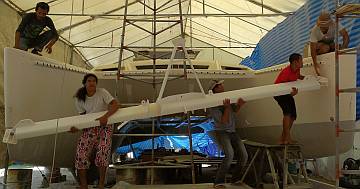
Lifting the forebeam up to see if it still fits...
105 Mount Forebeam
Summary: Most work this week focused on the salon, the heads, the spreaders, and several shelves, but the exciting stuff happened around the forebeam. Team accomplishments this week include:
|
 Lifting the forebeam up to see if it still fits... |
Monday, November 4: Test-positioning the forebeam
A sunny, energetic start to the week. And a cautious 7‑week countdown to a pre‑Christmas
splash.
Baw, Ben and Heru spent the morning sanding the last salon shelves, 3 teak and holly floor boards, a drawer, and a few odd pieces that missed out on the satin spray last week. We have decided not to spend $100 on another set of Epifanes polyurethane satin just for these pieces. We will go with Epifanes 1‑part satin varnish instead, which Baw is very confident about spraying well. While Sue (and the camera) were off on a morning errand, the spray happened, and by lunchtime all those pieces were sitting under Ocelot drying.
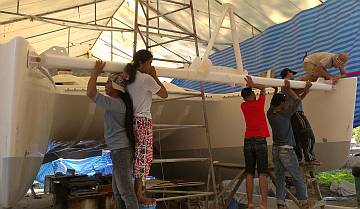 One end was bolted into place, but the other end wouldn't fit |
Jon spent the morning getting lessons in humility from the hinges for the portside engine‑room hatch. After drilling out the old mounting holes he realized that the hinges wouldn't fit because the holes didn't line up. The outer wall next to the engine hatch got enough filler that the hatch no longer fits where it used to. So Jon had to drill a new set of holes...
Sue's morning involved 4 errands on the scooter. She also sorted and wrapped all the finished floorboards and piled them according to "salon" or "cabins", straightened up the piles so that the new sprayed pieces had somewhere to go, and cleared the area for the forebeam testing.
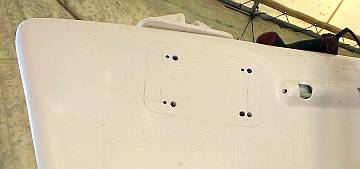 Old mounting holes on the right, new ones 17mm forward |
Just after lunch, Baw and the team disassembled the spray tent in front of Ocelot. The tables and scaffolding were moved, the forebeam was brought over from the side spray‑tent, and there was a general call to arms. Strong arms, to test the forebeam mounting location. The end‑brackets were bolted onto the forebeam with their massive 20mm (¾") bolts (and lots of nudging and wiggling) and what husky guys we could manage stood on a table and hoisted the forebeam into position. We bolted one side to the hull and then put a rope around the other end to winch it into position with our recently mounted big mainsheet winch. We put the best part of a ton of force on the end of the beam but the hulls were not going to move apart at all (nice to know Ocelot's so stiff).
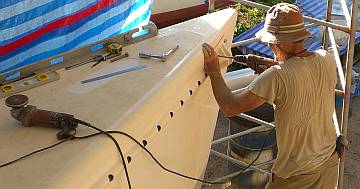 Forebeam brackets were moved forward on both sides |
We swapped the end‑brackets and tried again, with much the same results, but this time we measured how far we were from the original location: 34mm or about 1.3". So we lowered the forebeam and sent the men off to their other tasks while Jon realized he had a full afternoon of work ahead. If we moved where each end‑bracket bolted to the hull forward by 34/2=17mm (just under ¾") then the beam should fit (this is surprisingly close to Jon's estimate of 18mm from last week).
Jon marked the exact lines where the 4 new bolt holes were to go. He drilled 6mm (¼") pilot holes, with Sue on deck spotting down while Jon spotted horizontally to make sure the bolt angles were the same as before. Then he drilled one full sized 12mm (½") hole and used it to bolt an end‑bracket to its new location. With the end‑bracket correctly positioned on the outside and the thick aluminum backing plate positioned on the inside, he used the existing holes in the end‑bracket to match‑drill the new holes. Then he repeated the whole process over on the other bow. By day's end he had both brackets settled into their new positions. We should be ready for another lift‑and‑test first thing in the morning.
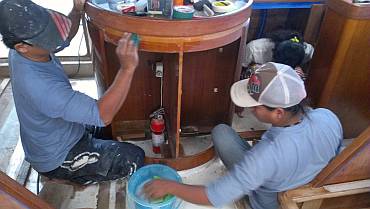 Lots of sanding happening in the salon |
In the salon we had Lek and Pla sanding the salon seats and seat backs. Lek pulled the old staples from the backrest where we'd had Velcro strips before. Heru and Chambron, when they were not on the forebeam project, worked on the gelcoat strip under the peninsula and the nav‑station, working up through finer and finer grits to polish it white. Lek put some epoxy down between the bulkhead and the port seat to close a gap, but a couple hours later Sue realized it wasn't pushed tightly closed, so she asked Baw and Lek to brace it. They stayed 20 minutes overtime to do so and got a small monetary thank you.
Ben and Baw spent the afternoon sanding the salon seat hatches (the boards that close the seats, and hide all our food storage). Years ago we had cemented Velcro strips onto them so they lifted with the seat cushions, giving us easier access. Today Ben and Baw despaired of ever getting the old rubber cement residue off until Baw pulled out the triangular varnish scraper and with ear‑splitting screeches managed to get it all off. All these pieces, and the salon seats up in the boat, are getting ready for their own quickie layers of polyurethane to protect the wood.
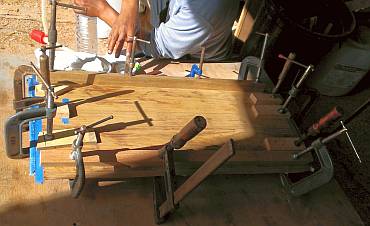 New veneer being epoxied onto the curved door |
Houa worked on the teak trim for the second rounded salon locker door. He has done a lot of the work on it on his own time, as agreed, but today we asked him to please put in more time so that it can get put in the varnishing pipeline and get caught up with the other locker doors in the salon and galley. He epoxied the new veneer and the surrounding trim on, then gave it to Baw to carefully sand the veneer before applying the first of 3 coats of West epoxy.
In the morning Jon had picked up the 2 sections of aluminum frame for the sliding door, with new strips of rubber gasket, but we weren't pleased with it. We showed Houa and all agreed the new rubber is too thin and squishy and falls out too easily. The thought of sliding that door open and closed every day and having the gasket suddenly bunch up and fall out of its groove was not nice. So we asked Houa to please go on a hunt for a better piece of gasket, a job best suited to someone who speaks Thai and knows exactly what we're looking for and what will work and what won't. So Houa scootered off at 3:30 and since he didn't return right away, it means he had to go farther afield in his search than the local shop who did the first "repair" for us. Too bad we didn't ask to keep the old gasket, as we might have been better off making it work, than having it thrown away.
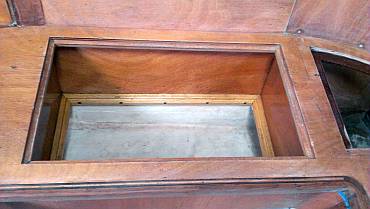 A salon storage-locker, with top & bottom hatches removed |
Tuesday, November 5: Retest and Respray Forebeam
A hot, new Northeast Monsoon day which started out slow, them zoomed on to some good stuff.
We already knew that Baw would be at the hospital today, but had not realized that meant his brother Ben was also gone. And Chambron was absent. But at least Yando arrived. Baw had made a point of being sure the men all knew what they were to do, so everyone moved to their stations. Heru continued the hand sanding of the hatch covers for the food lockers from the salon.
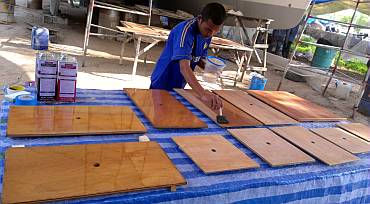 Ben sanded & polyurethaned many hatches and shelves |
Lek, Pla and Yando worked in the salon, with the floor stand fan on full blast to move some air around up there. There's no doubt that heat rises, and it is way hotter up under the tent inside Ocelot than it is down on the ground. Yando continued the sanding and polishing of the gelcoat under the seats and it's looking very white and new. Pla and Lek sanded the locker seats and backs.
Houa had not had a successful journey to the aluminum sliding door companies, so we are still without a sturdy gasket for the door. We have some leads on other places to try, but that will have to wait. Houa got to work on mounting the plastic board frames around the base of the doors inside the heads. These had been cut and shaped months ago, and just never installed. Now he is gung‑ho to get it done. Houa also asked if we would re‑hire Bo, this time not to clean but to hand sand the floor stringers. We agreed, on the proviso that Houa keep an eye on her and be sure she is working to his satisfaction. Apparently she did fine, getting the stringers in the aft cabins sanded. Houa then put epoxy on the boards that were viable, and pulled out the bad ones. So he sort of had 2 jobs going all day, plus supervision of Bo for half a day.
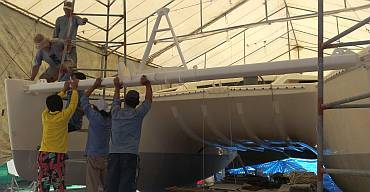 Wrestling the forebeam into position |
Jon's main project was to see if his new forebeam mounting location would work. He re‑mounted the brackets to the ends of the forebeam and shortened 4 of the 8 big stainless steel bolts so they'd fit better. We called all the men to the forebeam and hoisted it up. This time we slid the bolts home on port easily, and then tried to get the bracket to line up on starboard. It didn't just slip into place, but with a bit of winching it nestled in and the guys got the bolts in. Voila! One forebeam newly positioned. Too bad it couldn't just stay up there, but it needs another coat of paint, and it needs to have the bolts and backing plates settled in with silicone. So down it came, we quickly removed the end brackets, and the guys returned it to the spray tent and hung it up again.
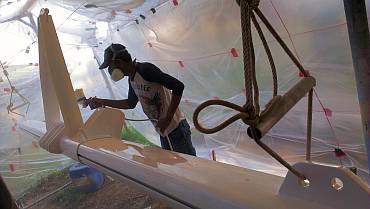 Baw sprayed 3 layers of polyurethane top-coat on the forebeam! |
Jon then set about filling the old bolt holes. Sue cleaned out the holes with acetone and a rag and Jon put duct tape over the outside of the 8 holes. He mixed up some Thai epoxy, added some filler, filled a big syringe, and injected the goop into the holes. Heru's comment, "Today Mr. Jon doctor." Well, something like that. He got the 8 forebeam holes filled, and the 4 old holes for the port engine hatch hinges as well. It was touch and go if he would make it before the epoxy cured. We had cruising friends drop by (who we've not seen for 3 months) and we got to talking while Jon mixed the resin, and it got hot in his hands!
Our happy surprise after lunch was that Baw and Ben had arrived. Ben took over the sanding of the salon locker hatch boards while Heru sanded and cleaned the forebeam for its final coats of paint. Baw then spent an hour spraying on 3 more top‑coats of Interthane 990 which we had tinted Ocelot White to match the boat. He wants to let the forebeam rest for 3 days before attempting to mount it on the boat again, to allow the paint to fully cure.
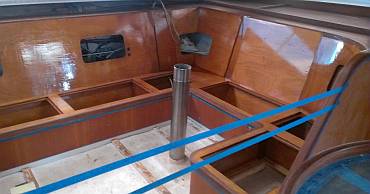 Lek got the first coat of gloss polyurethane on the salon seats |
Up in the salon, Lek cleaned up the morning's sanding mess and he got a coat of clean polyurethane varnish on all of the interior lockers under the seats and on the back rests. We had talked about only putting on one coat, but some of this one came out a bit heavy and streaky, and we're sure they'll want to sand it back. We're also not sure we want gloss varnish left on all those areas, as it is so shiny it looks wet. When we're looking down into a locker of food, we don't want to be constantly wondering if that's a puddle of water in there, or just shiny varnish. We will probably top coat it all with satin.
Once the forebeam situation was laid to rest, Sue and Jon got to sit and re‑group. What next? We choose to concentrate on the getting the anchor windlass and the chain stripper mounted to the foredeck. So we hoofed it off to the storeroom and Jon lugged the Lofrans windlass back to Ocelot. Sue spent an hour cleaning it up. Getting scale and grunge off the base, and silicone and other sealants off the long bolts. We know it needs to have its oil changed, and it will be fun trying to find the 4 bolt‑holes (now covered in gelcoat) as the mounting position is fairly tricky. Assuming no emergencies, this will be our project for tomorrow morning.
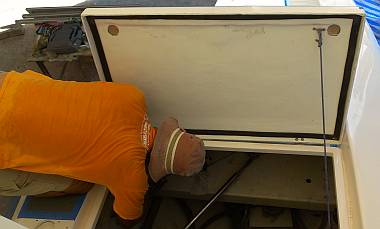 Jon finishing up the hinges on the portside engine-hatch |
Wednesday, November 6:
We're getting spoiled. If something isn't painted, mounted or finished it feels like a
hum‑drum day. But we have to remember that most projects are 98% preparation. So today
was part of the 98% and still a good day. Although the temperature on the boat hit 98°F/37°C...
Sue started the day by crawling into all four cabins and removing the plywood hatches on the bunks and passing them down to the Sanding Team in the shade in front of Ocelot. Since we're going to coat the bunks with polyurethane, the easiest way to do their removable hatches is to remove them. So Chambron, Ben and Yando spent the day on those 7 (some huge) hatches and the back sides of the salon locker hatches. Sanding, sanding, sanding.
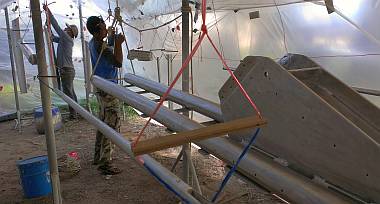 The paint tent is getting crowded now with all the mast bits |
Baw and Heru wore face masks to protect from aluminum grindings as they worked on roughing up the spreaders (both flat spreaders and long bars) and the prod. Once each item was ready they took it to the spray tent and hung it up. Thank goodness Sue and Jon were prowling around after lunch and noticed that we still had 2 spreaders inserted into the mast, keeping it oriented correctly. But we wanted to get all the spreaders painted at the same time, so we rallied the troops and the men lifted and turned the mast so that it is resting on a wider side and doesn't need support. Baw and Heru got everything hung nicely in the spray tent, and with some luck (and weather permitting) maybe they can get the green MaxCor primer sprayed on tomorrow.
Both Jon and Sue were a bit under the weather all day, so they chose quiet jobs that didn't take a lot of crawling around in small spaces or lifting heavy things. Sue spent the morning cleaning and sorting out the cockpit so that we can work on the deck hatches near the fan by the companionway. It's just too darned hot up there without the breeze. She also got a couple guys to help her move the big plastic box of hatches and hatch hardware from the store room to Ocelot. Then the guys moved our locked wooden tool box from under the neighboring boat to behind Ocelot. Sue keeps blue tape, a few small tools, and more hatch paraphernalia in there and we want it close by.
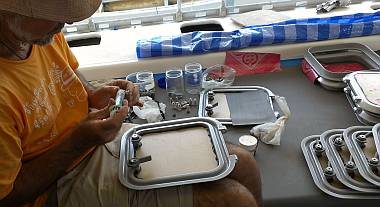 Jon assembling hatches, putting TefGel on the bolts |
While Sue organized and ran errands (a total of 5 scooter rides today) Jon finished up the hinge project on the port engine hatch. Next thing to do is to put the handles on and we'll be fully engine‑hatched. Then he and Sue moved on to the deck hatches. We now have 10 small hatches (having replaced the forward cabin ones with larger Lewmar hatches) all with new acrylic windows. These are the Goiot hatches for which we were trying to get parts from Europe, only semi‑successfully. Today we assembled the latches, which are plastic handles with aluminum inserts held down with stainless steel bolts, many of which had corroded to near uselessness. The aluminum inserts had been remanufactured by a local machine shop for 10% of the price that Goiot wanted, and we'd found better Phillips‑head bolts to replace the allen‑head bolts. This time we assembled them with lots of TefGel to limit the corrosion and to keep the latches lubricated. Next step will be the trickier pressure hinges and then mounting the hatches!
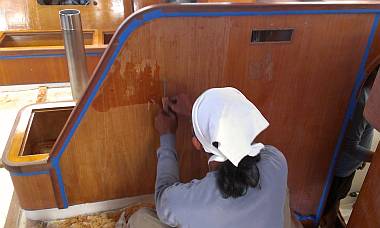 Note blemish above Lek's head as he works on the wall |
Houa was up and down from the passageways and heads again today. He got 2 more sets of plastic boards mounted in the bathrooms. He had Bo working with him again and actually taught her to use a hammer and chisel. He found some of the stringers outside the heads on port were rotten from long‑standing water damage, so he had her remove them. Then Bo sanded the floor, and Houa will be finishing up the sanding to his specifications, getting ready to put down new stringers. It is strangely still satisfying when they find bad wood and remove it. We are really getting down to the nitty‑gritty, knowing that there are no surprises left.
The nicest surprise of the day was the wall directly in front of the entryway. It was damaged long ago and even though Sue had revarnished it, we still had a big discolored patch. It's never looked right so we asked Lek to strip the varnish off whole wall and sand the teak veneer smooth before building the polyurethane up again. By days end the wall was nicely sanded, completely uniform, and ready for several coats of polyurethane. Clear polyurethane dries much faster than varnish so we can get more coats on faster, and we can get a hard, glossy finish fast. Then we can put on a layer of satin varnish so it will match the rest of the salon. Pla sanded the portside salon bulkhead, "mate" to the damaged one, but we are not taking it back to wood as its underlying varnish is still good.
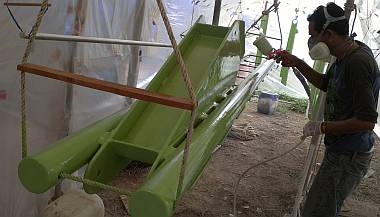 Bow sprayed primer on the anchor platform, prod, & spreader bits |
Thursday, November 7:
Another day in Paradise, long scooter rides, lots of chandlery shopping, many projects attacked, and
a house call for the washing machine repairman.
Our little top‑loader washing machine from the boat has been working here in the apartment for 2 years, but it's developed a plumbing problem - it sometimes leaves its drain‑valve open while it's trying to fill. So Jon walked to the local repair shop and got a ride back to the apartment with the repairman who spent about 20 minutes with the machine. He pulled out some bits of rubber from the water drain valve, tested the drain valve, then dropped Jon back near the road to the boatyard. House call, repaired machine, 2 rides: $3.00. Yep, three whole dollars.
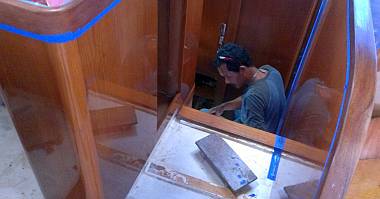 Baw brushed polyurethane onto both walls down to portside |
Sue, unfortunately, didn't get off quite so lucky on the buying front. A couple weeks ago we had a mess up with the Interseal 670 2‑part epoxy primer and used up too much of the hardener. When we tried to replace just the hardener, we learned we couldn't (unlike West epoxy which sells its Part A and B separately). So, $80 out the window instead of $20 for just the missing hardener. We also had to replenish the AwlGrip MaxCor green primer for aluminum, so that hit us another $160.
But we gained a lot of ground today. Baw, Heru and Chambron got the spreaders and the anchor support all acetone‑wiped (they had washed them with oxalic acid yesterday afternoon and rinsed everything in clean water). Then Baw sprayed on almost a liter of MaxCor, which is AwlGrip's green aluminum primer. Unfortunately, the narrow shapes meant that lots was lost to overspray.
It was a bit frustrating to hear first from Baw, and then from Toi of Yacht Supply (from whom we buy the MaxCor) that it's okay to overcoat the MaxCor right away. That's NOT what the spec sheets say. In fact, at our temperatures the window for over‑coating is 7‑72 hours. If you don't get it over‑coated within that time frame, you have to strip it off and start over. We chose to ignore suggestions to overcoat immediately, and are waiting until tomorrow morning to overcoat.
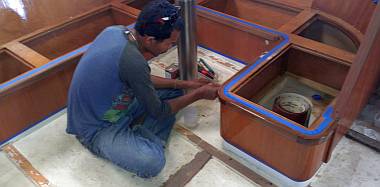 The skirts of the salon seats got their first coat of polyurethane |
Sue was gone all morning until 2pm running scooter errands. She stopped at Rolly Tasker, our huge sail loft, to track down our mainsail. We left it there over a year ago to be cleaned, and had never gotten a call back. Luckily they found it right away, unrolled it to check for any needed repairs (at Sue's request), and we realized it hadn't been cleaned yet. Well, no real rush, but it will be nice to get it back in hand.
Then she went up to Boat Lagoon to buy our next batch of AwlGrip MaxCor and try to hunt down some bilge pump covers for the aft deck. No luck. They are sold only with the whole Whale pump system. Time to try the USA. She also tried to find a big aluminum and glass store to search for better gaskets for our companionway sliding door, but hit a dead end. USA? We hope not, as we'd like to re‑install the door ASAP.
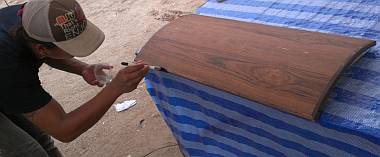 Heru putting another coat of epoxy on the curved locker door |
Sue returned to the yard to find that Jon felt under the weather and had retired to the room. But Sue was happy to see the men attacking a lot of new projects. Ben worked all day under Ocelot and got all the loose bunk and salon locker hatches coated in polyurethane. Heru sanded the second rounded locker door (the one that had to be rebuilt with new veneer) and got its second coat of West epoxy put on.
Up in the boat Houa was placing more of the plastic board in the last head. Bo was sanding the stringers under the floor boards. Pla was sanding under the nav station and bits and places around the galley and the peninsula so that Baw could brush on polyurethane. We are venturing into sort of new territory, in that Baw is putting new 2‑part polyurethane over what may be 1‑part varnish. This is traditionally a no‑no as the solvents in the 2‑part coating might dissolve the underlying varnish. But we've been reading of many instances where this is not the case, especially over‑coating old, established varnish. We Shall See. Baw's request to use polyurethane instead of gloss varnish is mostly a matter of speed. It dries much faster than varnish which means it can be sanded sooner for another coat, and we can work around it in tight quarters that much sooner. Let's hope we don't end up having to scrape it all off!
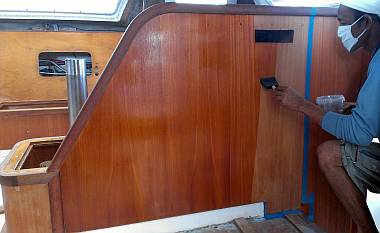 Nice polyurethane but it didn't match the rest of the wall |
The big bulkhead that Lek had scraped down to raw teak and put a layer of polyurethane on yesterday got sanded today. But then it appeared that the color variation between that section and the old varnish on the rest of the same bulkhead was very noticeable. Not beautiful. In fact, a bit striped looking. So we asked Lek to take back the rest of that bulkhead to raw teak, sand it and put on the same polyurethane coating. It's another day of work, but it will look much better, and what's more important, it won't drive us nuts.
Chambron and Yando made quick work of sanding the port cabin bunks (not that there's a lot left to sand when the huge hatches over the water tanks are out). But after sanding, they gave them an acetone wipe (yes, we're plowing through the acetone these days!) and brushed on a rich coat of polyurethane. Voila! Two cabins DONE. Tomorrow we get to move all the Ocelot tools from starboard aft cabin to one of the port cabins, so the bunks on starboard can be sanded and coated.
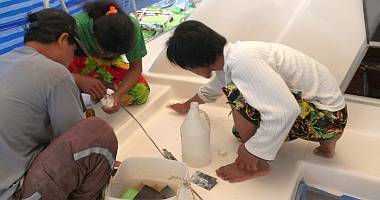 Patching some bad gelcoat to port of the galley window |
Out in the cockpit, Pla and Yando sanded down the banana‑shaped gelcoat damage, and drill‑sanded the little holes in the gelcoat. Then Chambron appeared with a small cup of gelcoat and catalyst and paddled it onto the damage and did the dit‑dot thing into the small holes. We had wondered if maybe that area was going to be spray‑repaired, but apparently not. Now there is just the helm seat and a small area on the aft deck that probably will be spray‑repaired.
A fun last minute exercise involved bringing up all the light plywood seat locker covers and the bottom food locker shelves (all nicely coated in glossy polyurethane) and trying to mix and match them back to where they go. We got lots of them in place, but not all. The shiny wood looks great, and we'll probably keep it glossy inside the lockers.
Friday, November 8: Mount Forebeam!
A fun, busy day, with a major landmark event!
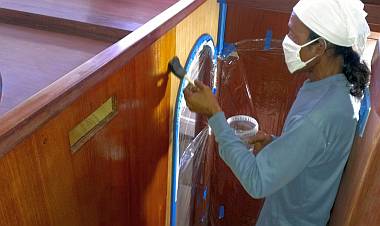 New polyurethane after taking off ALL the old varnish - looks nice |
There aren't many loose pieces of wood left to varnish, but the few that needed attention were taken care of by Ben. We are so pleased with how Ben is working. He has come a long way since he first showed up at our boat a year ago as Baw's little brother (and Baw found it necessary to fire him). Now he's a pretty good worker in his own right.
Lek continued to remove the old varnish from the starboard bulkhead in the salon. And in the afternoon he got the first coat of polyurethane on the bare wood, so now that whole wall is uniform in color. It was worth the effort.
With the portside cabin bunks all nicely coated in polyurethane we moved all of the Ocelot tools and supplies from starboard aft to port aft. Again Chambron and Yando worked quietly and efficiently in the cabins, sanding and cleaning. By afternoon the boat was filled with the sweet chemical smell of new polyurethane and we could look down through the hatch openings to see the shiny new coating on the starboard bunks. Four cabins done!
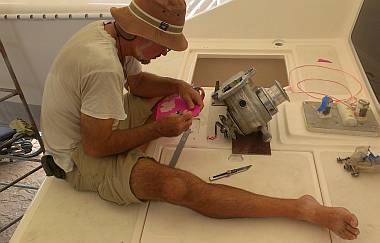 Playing with templates for the (upside down) anchor winch |
Pla spent the morning on the small gelcoat repairs outside the galley window. He went through the whole routine of pencil marking the spot then sanding that off with increasingly finer and finer grit sandpaper. Everything is blended in now, so that area will be ready for the final polish.
Jon's morning job involved making 2 templates of the base of the windlass and its bolt pattern. Placing the windlass is quite critical, as there's a wall running underneath it, but all of the previous bolt holes have been covered up on deck. Some are visible from inside the chain‑locker but they can't all be drilled from down there as some are too close to that wall. So Jon made a full template with all the holes needed, as well as a partial template with the 3 holes that fall on the starboard side of the wall. Using the smaller template he could drill small "marker" holes up from the chain locker, which will allow him to align the full template up on deck to drill the complete set of holes.
Sue spent more than an hour on the internet last night, looking at aluminum door companies and their gasket products both here in Thailand and in the USA and Australia. Finally she found Bangkok Aluminium, with a branch in Phuket, and encouragingly, one of their "brags" was that they import European sliding doors with larger grooves. Hmm... Sounds just like what we need. A few phone calls and consultation with Houa on the map, and Jon scootered off to see what they had. They weren't very willing to part with the gasket as they claimed it was special order and all that, but he was finally able to buy 4m (13') of it.
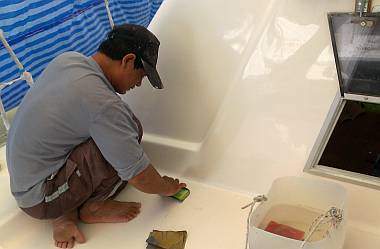 Pla sanding the new gelcoat until it matches neighboring gelcoat |
While he was in town he stopped at a car parts store to buy anchor‑winch relays. These are very similar to starter solenoids, but starter solenoids are typically only active for a few seconds while the anchor winch may remain active for several minutes while we recover our anchor(s). They had no "continuous duty" solenoids, so Jon continued on to a somewhat marine hardware store, which sold him a pair of continuous duty 100A solenoids for $50 each.
Getting the new rubber gasket material to fit into the old, slightly corroded tracks on the door frame took several hours of patient pulling, Dremmel grinding, wire brush scrubbing, and lubricating with detergent. But it is the right stuff and won't fall out! Jon showed Houa that the top and bottoms of the door are now ready, and Houa pointed to the 2 side pieces and said, "You buy rubber for this too?" Dang. One more trip to Phuket town.
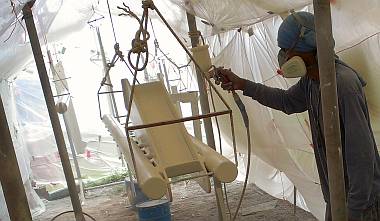 Darth Baw spraying 3 mid-coats on the anchor support |
Baw, Ben and Heru lightly sanded the green MaxCor primer on all the spreader pieces and the anchor support. Then they set up for a white Interseal 670 mid‑coat spray. Baw spent over an hour in the tent and got three coats on everything. Of course, we realized too late that we should not have put so much paint on the ends of the flat spreaders that slide into brackets on the mast, or they won't fit. Oh well, nothing a little sandpaper can't cure.
The momentous landmark event of the day came after lunch. Jon got all his "ducks" lined up (socket wrench, shifting spanners, silicone gun, extra silicone, bolts, rags, acetone, etc) and we gathered all the men for the Great Mounting of the Forebeam. The first trick was getting the hefty bolts through the forebeam and its brackets. Too much beautiful white paint! So instead of sanding down the paint, the men decided to thin the plastic washers a bit by sanding them, flat on a table on top of sandpaper. Finally both big bolts slid home, but not without a bit of percussive persuasion.
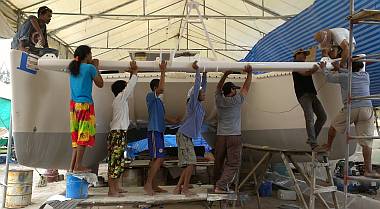 Starboard went easily, port took some grunting (but no winching) |
Then Baw quickly sanded the bracket bases, wiped them with acetone, Jon applied a liberal sploob of silicone over all, and the men lifted! The plan was to slide starboard home first and get 3 bolts in, then bully portside into place (with a winch if necessary). It all went pretty smoothly, probably because of the slippery silicone on the ends, and no winching was needed, which means there will be less load on the forebeam bolts.
Once we had 3 of the 4 bolts in each end we let the men return to their jobs. Baw and Heru stayed to be Jon's assistants in setting the bolts in place with silicone and helping with the tightening process. We can't say it went without a hitch, but it did move along. The bolts had to be removed one at a time, squirted with beads of Sony clear 6301 silicone, and pushed back in. Then the guys held the bolt head with a shifting spanner while Jon tightened the lock nuts on the inside. All in all he was down in the fo'c's'les for more than 30 minutes, sweating profusely. But Yay! It got done! Baw took a celebratory walk across the forebeam.
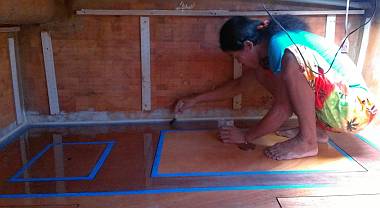 Chambron got new polyurethane on Amanda's port aft cabin bed |
With the forebeam in place many other things can be mounted. High on the list will be the anchor support that goes between the trampolines. Tomorrow we want to see how it fits as we know its bracket will need a backing plate to move it forward. To that end, Sue scavenged in the store room for the big pins that hold the anchor support to the forebeam and the boat. Ironically, in the same bag as the pins she found the "missing" 8 bolts that used to hold the forebeam in place. Yes, we'd had to buy new ones from AME, cut 4 of them down in length, make sure we had locking nuts for them and all that. But Sue's main "regret" in finding the old ones just a couple hours too late is that now we will no doubt sail around with those bolts for the rest of our sailing days, as they're too valuable to throw away.
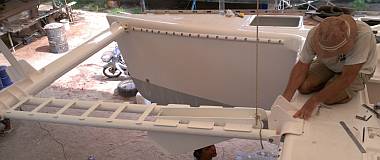 Testing the anchor platform - note gap between bracket & hull |
Houa got the last plastic board trim attached to the bathroom walls with Sika, and clamped in place for the night. He also cut several new floor stringers from 12mm (½") plywood, which will replace the water damaged ones in the passageways and outside the heads.
Saturday, November 9: Test Anchor Platform Fit
End of Week 1 of our 7‑Week Plan, and we're ahead on some things and behind on others. But it
was a good day, all in all.
The main excitement of the day was the raising of the anchor support, the big complex hunk of aluminum that goes between the boat and the forebeam, between the 2 trampolines. Because we had moved the forebeam forward by 17mm, we certainly expected the anchor support to fall short by that amount. While the men held the beam up, Jon and Chambron whacked the pins home, then Jon tied up the aft end so he could play with it. He decided the best way to judge the shortage was to attach the anchor support beam to its bracket, then see how far from the boat the bracket fell. We expected 17mm but the gap was 22mm. Not sure where we lost 5mm (almost ¼"). It's a boat.
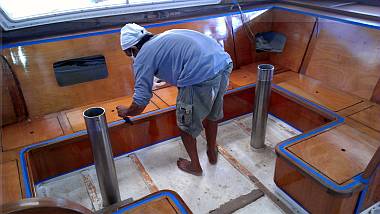 Lek brushed another coat of polyurethane onto the salon seats |
We consulted Houa, and he'll be able to build us a solid teak backing plate under the bracket, matched to the hull, to move the bracket forward by the 22mm we need.
Down under Ocelot Baw, Ben and other men spent the day sanding the white primer on all the various spreaders, poles, prod and anchor support. They'll also fill any dings and pretty things up as best they can.
In the salon, Lek and Pla worked on the teak again. They sanded and cleaned and then Lek put another layer of gloss polyurethane on the starboard bulkhead, and late in the afternoon he got another coat on the seat fronts and inside the locker at the end of the galley peninsula.
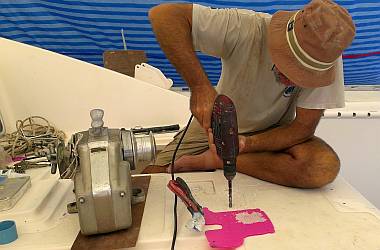 Drilling the 10mm (3/8") mounting holes for the anchor winch |
Houa and his sidekick Bo (who he seems to be happy to supervise) worked on the stringers in the port cabins. Bo sanded and cleaned the areas, and Houa glued the new stringers down with Hartford Epoxy glue, in both the forward and the aft cabins. All this work in the cabins and passageways made it a bit awkward to get in and out to access our tools, but everyone was pretty accommodating.
After Jon played with the positioning of the anchor support, he and Sue spent some time discussing the positioning of the windlass and its attendant chain stripper. The whole area where the hardware is to be mounted was de‑cored and fiberglassed, so that gives us good leeway in where to mount them. Since we're moving the anchor aft, there will be a more acute angle for the chain to take to the windlass, so we've decided to mount the windlass with a slight offset to accommodate the change. Jon got pilot holes drilled, and then the bolt holes themselves. But then it was lunch time, and our Swiss friends came by, so this project went on hold.
Jon's after‑lunch project was to return to Phuket town to buy more of the rubber weather stripping for the entryway sliding door. While there he saw a better suited gasket and is awaiting a call back to see if they can get it. No holding our breath, though. Then he prowled through the shelves of G. C. Huat, a hardware cum chandlery store, to try and find the parts to enable him to create a truly opening and closing valve for the saildrive raw water intake. It was an exercise in plumbing creativity on the run. He brought back some pieces and will be playing with them on Monday.
Sue did her usual errands for foam brushes, rags, plastic sheeting, duct tape and the Saturday bank run. Yes, some banks are open on Saturday, all day! The good news is that the yard manager, Cris, in easing back from his duties (he will be leaving in December or January) generously dropped his $50/week commission from our two workers, Lek and Pla, who we had hired through him. A lower payroll without a reduction in man‑power. Now there's a happy thought!
Thai Refit:
Ocelot Pages:
Top Level: Home | Destinations | Cruising Info | Underwater | Boat Guests | Ocelot | Sue | Jon | Amanda | Chris | Site Map | Make a Comment
|
If our information is useful, you can help by making a donation |
Copyright © 2000‑ Contact: Jon and Sue Hacking -- HackingFamily.com, svOcelot.com. All rights reserved.